Summary
Tropical Cyclone Oswald briefly reached tropical cyclone intensity near the Queensland Gulf of Carpentaria coast but was then responsible for flooding rainfall across large parts of Queensland. A tropical low near the southwest Gulf of Carpentaria coast on 20 January tracked eastward across the Gulf and was named Category 1 Tropical Cyclone Oswald on the afternoon of 21 January. Oswald then crossed the western Cape York Peninsula coast near Kowanyama early on 22 January. Strong onshore monsoonal winds affected the western Cape. Weipa recorded a peak wind gust of 55 kn (100 km/h) and high tides rose above the highest astronomical tide level.
The remnant low tracked to the southeast just inland of Queensland's east coast and produced severe weather over nearly all of eastern Queensland during the following week. Destructive winds were recorded at Hay Point, near Mackay. Winds over the water were enhanced by the prevailing synoptic flow. The low was slow moving west of Rockhampton on 25-26 January, producing over 1000 mm of rainfall in some areas during the 48 hours and major flooding.
Over the Wide Bay and Burnett district the system had an even larger impact, with record flooding in the Burnett River, and major flooding in the Mary River. An outbreak of at least five confirmed tornadoes, the numerically largest known in Australia, occurred on the coast near Bundaberg on 26 January, with destruction occurring particularly in the towns of Bargara and Burrum Heads.
On 27 January the low moved further to the southeast, and far southeastern Queensland, including Brisbane, the Sunshine Coast, and the Gold Coast was impacted by high winds, torrential rain, dangerous surf, and tidal inundation for up to 24 hours. The Lockyer Creek, Bremer River, and the Brisbane River all flooded, though the flooding in the Brisbane River did not reach the levels seen in the 2013 floods.
The low moved south into New South Wales on 28 January and continued to cause torrential rainfall and major flooding northeastern New South Wales.
Track and Intensity (Time in AEST (UTC+10h))

Rainfall for the week ending 29 January 2013.











